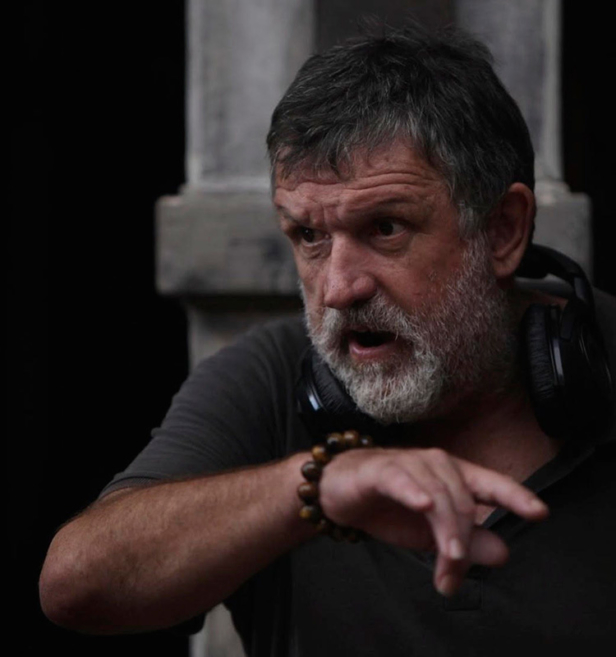An eye fills the lens, the camera pulling back to reveal the haunted face of Dominar Rygel XVI, the diminutive deposed despot whose function over the previous six episodes of Farscape had been to either heighten the danger through selfishness or deliver pompous putdowns.
It’s immediately obvious that things have changed. The comedy space toad is going to do a lot of heavy lifting this episode. Floating ominously before the crew of Moya like a ruined cathedral is the Peacekeeper command carrier Zelbinion, where Rygel was first held prisoner, tortured and humiliated by the sadistic Captain Selto Durka over 100 cycles (or years, probably) before the events of Farscape begin.
“Yeah, funnily enough, it’s the emotional puppet stuff that I really liked,” muses Australian director Tony Tilse over Zoom from one of the islands of Indonesia where his latest show is in pre-production. “Which I hadn’t thought about. When people first get to this show they’re like ‘It’s just a puppet.’ So you’ve got to go, ‘Can I make people suspend their disbelief? Can I make this become a real person?’”
First broadcast on April 16th, 1999, ‘PK Tech Girl’ (S1, Ep7) is often regarded as Farscape’s turning point. A step away from the sort of encounter-of-the-week stories that wouldn’t have looked out of place in Star Trek: The Next Generation and into much darker territory, with a far greater sense of consequence and character development. All shows evolve as their creators and cast get a better feel for what works and who their audience is, but the steepness of the climb was perhaps exacerbated by diffusion of demands from the stakeholders. As a co-production between The Jim Henson Company, its longstanding production partner Hallmark, and Australia’s Nine Network – plus the influence of the Sci-Fi Channel which largely dictated its success in the US – Farscape was born with the risk of wildly different objectives and expectations.
“In that first season, I think Farscape was still trying to find its tone,” agrees Tony. “Part of it was because you had The Jim Henson Company, you had the Sci-Fi Channel, you had these factors to try to balance out [and ask] ‘What is the show? Is it family viewing?’
Small Screen, Big Dream
We do know. We know because ‘PK Tech Girl’ is a very obvious slice of magic. The Zelbinion interior was filmed on location at a disused power station, giving it a sense of scale and industrial decay that a studio set might lack, and these corridors are approached with cinematic aspirations. Aeryn Sun (Claudia Black) strips to a vest and channels Ellen Ripley (with a pinch of Sarah Connor), an oversized cannon at her hip as she stalks claustrophobic smoke-filled corridors – all shot from below as if some unseen Giger-esque obscenity is set to drop down onto her back. Both Rygel and the titular tech girl, Gilina Renaez (Alyssa-Jane Cook), get to briefly play the role of Newt as they scrabble from shadow to shadow in panic, the former pursued by memories and the latter fleeing the boarding party of John and Aeryn.
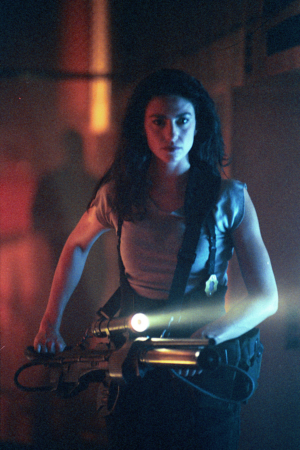
What she’s really scared of are the Sheyangs, toad-like scavengers with cruel shark eyes and petulant mouths, who had grilled her teammates by belching fire. Their one redeeming feature – as far as our heroes are concerned – is that they are incredibly dense (figuratively as well as literally, they waddle around their ship with the elegance of baked potatoes) and prone to fighting amongst themselves. Another con: their ship is basically a rocket battery with a bridge attached and Moya stands no chance. Another pro: it takes seemingly forever to prime a salvo and they’re soon deterred by D’Argo shouting at them. But hey, this is Farscape and it’s more than capable of being goofy and gruesome all at the same time.
“When the series started,” says Tony. “I was offered that one episode. That was my offer for the season. They were still working out the rest of the season. I’m a fan of sci-fi and, yes, I was playing in James Cameron’s territory and Ridley Scott’s territory.”
Jumping forward to Tony’s second episode, ‘Till the Blood Runs Clear’ (S1, Ep11), he plays around with the conventions of the Western to a similarly gleeful degree, with a low shot of D’Argo jumping from the Prowler and into the sand as if he were dismounting from a horse and close-ups of faces as John attempts to stare down the two feral bounty hunters. There’s an element of pastiche, sure, but whilst Australian cinema came of age in the 1970s, Australian TV in the 1990s – produced for a small domestic market, with zero export potential beyond Ramsay Street and Summer Bay – gave directors little opportunity to go big. Tony’s resumé prior to Farscape consists – like most of his contemporaries – of police dramas, hospital dramas, and Bananas in Pajamas.
“What Farscape allowed me to do is go, ‘I can do genre, I can do genre’. And so from that point onwards, I really have chosen – as much as I can – genre shows. Hey, it got me to do the Sam Raimi series, Ash vs. Evil Dead, and the fanboy in me goes, ‘Oh, my God, I’m here with the cabin being rebuilt in the forest with Bruce Campbell’. I’m just kind of going ‘I think I’m just gonna kind of wet myself’. Farscape allowed me to dream big, you know? So that was sort of the start of my progression, especially in genre because now I’m here in Asia doing horror and the last job here was a ‘Nasi Goreng Western’ [as in ‘Spaghetti Western’, meaning a cowboy movie filmed in Italy]. So it was an Indonesian Western for HBO Asia.
“In Australia, we had done a lot of shows that were much lower in the budget terms and so we’d see these fantastic American shows come in, and we go, ‘Oh, yeah, but if we had that money, we could do that’. [Farscape] turns up and then you go, ‘Hmm, okay, I’ve got some money – put up or shut up’. So I felt like I had to go, ‘Okay, well, now I’ve got a bit of a sandbox to play with. I have to make sure I can do the best I can and I can have some fun with it’.”
They certainly had fun. Between the explosives and the flame-throwing Sheyangs, an inferno of pyro is lit on ‘PK Tech Girl’, and the production makes enthusiastic use of the physical space. One Sheyang ducks his head through a ceiling hatch to burble at his shipmates, and in the climactic finale Aeryn abseils down at a critical moment to save John and Gilina from certain death. Where was she? How did she get up there? Why did she have to be abseiling? Oh, it doesn’t matter.
“I was a kid in the candy store going, ‘Let’s blow up this’, ‘Let’s pull up that’, ‘Let’s do that’,” recalls Tony with a twinkle. “‘Let’s do those things that I’ve always wanted to try.’ you know, and, ‘Let’s have Aeryn abseil down from this from the top of this thing’. And, you know, ‘have the fire creatures blow up and burn stuff’.”
The Wizard of Oz
One of the idiosyncrasies of Farscape’s production was the sometimes awkward hybrid between North American and Australian systems. Typically for a genre show, the executive producer/s – the Alex Kurtzmans or Chris Carters – would call the shots, sitting atop the production pyramid like a Pharoah. In Australia – much like the UK at the time – the director took the episode from beginning to end, contributing to the creative ‘schizophrenia’ (to use Tony’s phrasing). Considering that the show’s creators – Brian Henson and Rockne S. O’Bannon – were on the other side of the Pacific Ocean for much of the time, the directors had a greater role in establishing the sheer Farscape of Farscape than they get credit for.
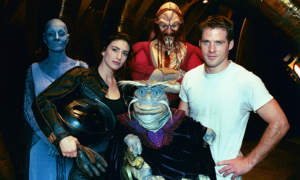
“In Australia, directors have a little bit more say, both in the production and in the editing, whilst in the American system, the directors have less input into the edit. They have a go at the scripts. And so I think with Farscape, the directors did have the opportunity to [have] a lot of input into the process. Now, whether they took what we said, is up to them. But look, the television medium is a producer’s medium, so the directors don’t necessarily get credit [and] that’s okay, we’re used to that.”
As well as Tony Tilse, Peter Andrikidis (starting with ‘The Flax’ – S1, Ep12), Ian Watson (starting with ‘They’ve Got a Secret’ – S1, Ep10), Rowan Woods (starting with ‘Back and Back and Back to the Future’ – S1, Ep5), and chief amongst them, the late Andrew Prowse (who directed the premiere, and later took on producer duties), became regular contributors. It’s reductive to credit Farscape’s coming of age to one person, but starting with ‘PK Tech Girl’ there was a shift towards more mature content and more cinematic treatment that opened the way to a higher caliber of storytelling, such as ‘DNA Mad Scientist’ (S1, Ep9) and ‘Rhapsody in Blue’ (S1, Ep12) which added psychological crisis, moral ambiguity and body horror to the freewheeling space opera. These elements would go on to become core components in the composition of Farscape.
“I’m happy to get the credit that I was part of that – that tonal shift for the season. I think that’s where Farscape found its rhythm and found its feet in that particular episode. So I feel very blessed and privileged to have the chance to have done that. I mean, the fans have been very kind to me about that episode. And, I know that the Sci-Fi Channel was very, very impressed with that episode. So that’s where it all sort of started and that’s when I became a regular director on the show from that point onwards.”
The Way We Learnt
Over the second half of the first season and especially into the first half of Season 2, Farscape settled into a groove with a regular crop of directors and the guidance of writer/producers like David Kemper, who like Rockne S. O’Bannon was a survivor from the sinking of SeaQuest DSV, and Ricky Manning. Fortunately, this didn’t curtail the room to manoeuvre that had allowed for such an artistic levelling up from Tony and his peers.
“You did have a lot of freedom,” he recalls, “Once you earn their trust, then you are invited into the writers’ room and become a little bit more of a showrunner model in the sense that there’s a team, there’s a team of writers and a team of directors who did it regularly. We could have the meeting, come in and say, ‘Look, I’ve always wanted to do….’ and ‘How can we…?”, and so you get the script, and you could work that around, and then modify that with your crazy ideas.
“I’d go, ‘Yeah, you try that’, ‘try that’ or ‘do that’. There’s a lot of give and take in that regard. In Season 2, Season 3, I was more heavily involved. It was a fantastic collaboration between us, the directors, and the writers, because I think we really understood what the series was and sometimes, we’d go a bit crazy, and they’d pull us up, but there was a lot of opportunity for us, as directors to [contribute] a very strong visual input, a very strong performance input into the show.
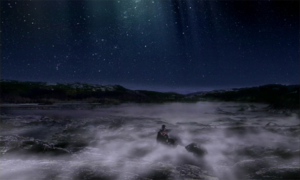
“The writers would come and say, ‘We’ve got this concept, we want to do this, this and this’. And then we could offer our say, how you could do it, how you could do it visually, or you can say, ‘Look, I can’t get this location, but I can get this location. What do you think about how we do this?’ So there was a great level of, as I said, collaboration, and a lot of fun with that. Especially when, you know, you have a rapport with your actors as well. Then because Ben [Browder] wrote some episodes himself, and, I was privileged enough to shoot some of Ben’s stuff. So Ben for me as a director and with the lead actor and the writer himself, we had a lot of playtime which is, which is great.”
In fact, Tony directed both of Ben’s scripts for Farscape – ‘Green Eyed Monster’ (S3, Ep8) and ‘John Quixote’ (S4, Ep7), a dramatically tense bottle episode and a gloriously silly budget-free knockabout respectively – which has its benefits, namely that the collaboration between writer and director can unfold on the spot, but having the talent involved at that level potential pitfalls.
“It can be a very dangerous process because you can start to go down a path that….” he pauses for thought before proceeding with what can only be described as the Australian affection for a bullshit-free environment.
Uncharted Tilse Stories
Somewhere in those same hazy borderlands between inventiveness and indulgence is Farscape cast’s legendary propensity for ad-libbing, a process that has produced some of the most memorable moments and quotable lines in the show’s run. But from a production standpoint it might be tempting to see this purely as time and money dribbling away, so what’s a conscientious young director in a high-pressure environment to do?
“When the rapport between Ben and Claudia was working, it was very important to not interrupt that rapport and let that become natural. So that was really great for us to be able to let them have a play, but, you know, David Kemper and Rockne and those guys are always in charge and so you knew when you went too far. Which I love them for, because they gave us a bit of rope and we’ll go away, and they the go ‘Guys, stop, come back, come back, you’ve gone too far.'”
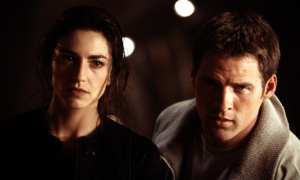
“The scripts are very, very tight scripts,” he says. “Some of them [had] tightness at certain points and there are other points where they wanted to give space for the actors to let the chemistry work. So the way they structured that series was very, very clever. And Ben was fantastic. He’s [got an] instinctive ability of ad-libbing. Once you get to those seasons where those actors are so in tune with their character, there’s some fantastic stuff that can come out from that.
As for how far is ‘too far’ for Farscape, Tony refuses to be drawn on specifics. (I tried but despite promising a ‘Release the Snyder Cut’-style fan campaign, he wouldn’t budge.)
“On one particular episode, we went quite, quite over the top. I’m not gonna name the episode. I did some shots that I deliberately put in the edit. They looked at the edit and they went, ‘Ah, you can’t have that shot. None of it.’ Ben and I still joke about that shot.”
He does however cheerily acknowledge that at least one episode perhaps winked too overtly at the show’s narrative conventions – ‘Scratch ‘n Sniff’ (S3, Ep13). “It was a very funny episode,” he reflects, “but we went a bit mad on that one. But that’s okay, that happens. It happens.”
Concerning Puppets
It’s kinda interesting that despite his reputation as the ‘action director’ – David Kemper used to dub him ‘Tony Woo’ – what really stands out from Tony’s time on Farscape are episodes which place so much drama in the rubbery mitts of the Jim Henson Creature Shop. Of course, there’s the aforementioned ‘PK Tech Girl’, but Tony drops us back down to Rygel’s POV for its follow up ‘Durka Returns’ (S1, Ep15), and in ‘A Bug’s Life’ (S1, Ep18) the miniature Machiavelli finds himself cornered in a vent by a crack Peacekeeper black ops team. If Tony Tilse is Farscape’s John Woo, then surely Dominar Rygel XVI is his Chow Yun-(very)Fat.
Frequently cited as amongst the show’s finest 40 minutes, ‘The Way We Weren’t’ (S2, Ep5) is another high watermark in content and creativity. Using a technique called ‘bleach bypass’, Tony gave the filmstock an oppressive, washed-out look to show Moya’s past as a bustling Peacekeeper transport. The location is familiar but the world we see is not one we recognize – all the love and light has been drained from it. Back in the present, we deal with the emotionally charged aftermath of the gang discovering the role that Aeryn played in the murder of Pilot’s predecessor. In expanding on both Aeryn and Pilot’s backstories, ‘The Way We Weren’t’ finds unexpected light in her shades of grey and unexpected darkness in his.
“That tonal look of those flashbacks gave me a key into the tone of the episode,” he says. “It’s a big Pilot episode. It’s a very, very, very, very big emotional episode.”
It is of course another Muppet melodrama, this time focused on the soulful Pilot whose big brown eyes had been a weary and wary witness to the goings-on of Moya’s passengers. His existence defined by service to both crew (he let them chop his arm off in ‘DNA Mad Scientist’ with substantially less fuss) and ship, here he acts independently for perhaps the first time – following his own emotional urges rather than acting as a conduit for the needs of others.
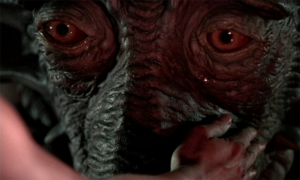
Talk of ‘The Way We Weren’t’ brings us right back to where we began this conversation, with the wide-eyed horror of Rygel in the artful opening shot of ‘PK Tech Girl’. It signposts the moment that Sparky becomes a fully rounded character with an inner life beyond the acquisition of big dinners and glittering geegaws. Tony seems to be considering his ‘emotional puppet’ canon for the first time:
“I think you’ve actually hit on something really interesting about the tonal change in that first series – Rygel became a strong emotional character. I’m not saying I did this consciously, but subconsciously, I think that’s part of my reason for the eye shot – the opening eye shot – to get that moment of coming out of Rygel’s head when Rygel was going to carry out quite a strong emotional weight to this particular episode.
“And I think that’s why ‘The Way We Weren’t’ is also really important because it’s an emotional context for Pilot and that’s the other thing I really liked about that was beings able to get into Pilot’s head. It’s something I haven’t actually really analyzed or thought about.”
Look Who’s Talking Woo
The more you pull at this thread, the more the throughline emerges (“It’s making me want to go look back at all my episodes,” he laughs. “Here’s the ongoing thing with these puppets…”). There’s also ‘Beware of Dog’ (S3, Ep14) where Aeryn bonds with a parasite-hunting critter with the flesh tones of a discarded Troll doll and a murderous split personality, and then has it die in her arms.
“You’ve got to look at how every moment impacts on our characters,” explains Tony, “and that was a big emotional impact for Aeryn, because suddenly you’ve got this pet that died. I think the script was slightly different to how that [ended up], because the transformation isn’t in the original draft, I think the other version of that creature was the one that was going to die. But I felt I just could not get the emotional response from that particular design and so we went back to the writers and that’s how we designed the ending of that. The other [creature] just felt much more vulnerable and expressive.”
It’s an established fact that Tony Tilse gives a good action scene and helped usher in a more dangerous tone to our favorite show, but what we probably don’t acknowledge enough is that there’s more to him than that – he can also make you weep for the plight of puppets. Is the nickname ‘Tony Woo’ misleading?
Not if you know your John Woo films.
“Yeah, I love the action, I’ll do all the action, but you still gotta get to the emotional heart of the story. I was obsessed with John Woo, but ultimately within his movies, it’s all about the emotional context and the action’s laid on top. It’s kind of interesting to look at [Farscape] now and go, ‘Yeah, those emotional stories are the ones that are really, really strong’.
“They’ve still got a layer of action on them but they’ve got a very, very strong emotional core.”
This article was taken from The Companion – subscribe here.
Farscape is showing on the Horror Channel from April 4th showing as part of its Sci Fi Zone. Main image courtesy of Tony Tilse.
